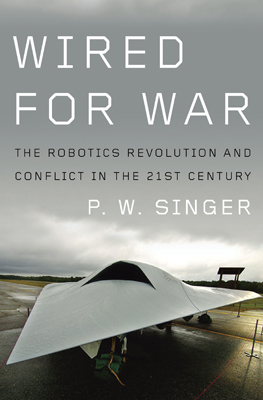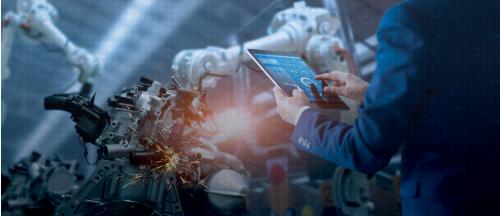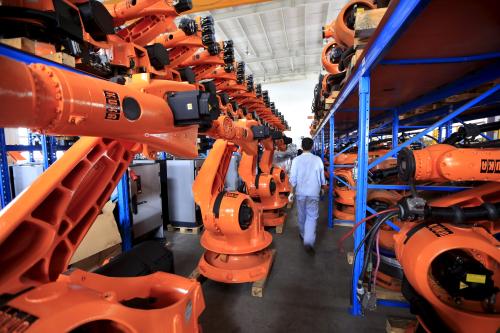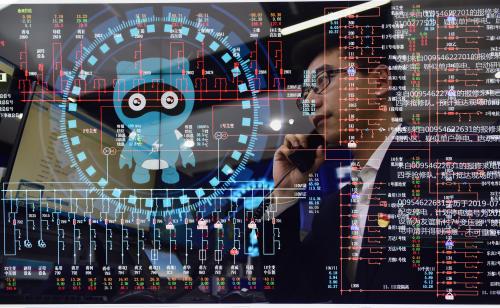The release last month by the Department of Transportation of guidelines for testing and deploying automated vehicles brought home for many the fact that self-driving cars are at our door, representing an unprecedented opportunity for transportation safety as well as cost and energy savings. But for many others, autonomous vehicles symbolize how artificial intelligence and robots are eliminating jobs.
Few economic themes capture the attention of the media, politicians, and the public as strongly as the worry that automation threatens employment. The concern is easy to understand: robots are now ubiquitous within manufacturing, a sector that has lost 5 million workers since 2000. And it’s easy to point to occupations, like travel agents, that have all but disappeared due to automation and the internet. But is automation really to blame?
First, as I’ve written before, at the national level there is no correlation between adoption of robots and job losses in the manufacturing sector. Countries that deploy far more robots in manufacturing than we do have lost far fewer manufacturing jobs.
Second, automation also creates jobs, but it’s harder to identify the occupations that have been created or sustained because of automation than to identify the occupations that might be threatened. Technology can lead to jobs by creating new industries (Airbnb, Uber) and bolstering firm competitiveness, and it can lead to wage growth by reducing prices, which raises purchasing power. The deployment of ATMs in the 1990s actually led to an increase in the number of bank tellers because, with the cost of operating branches reduced, banks opened new ones. Also, thanks to cost-saving robots it now takes fewer hours of work for a middle-income wage earner to afford a car than at any time in history. In an era of stagnant wages, reduced prices help low- and middle-income families stay afloat.
New automation technology also democratizes the ability of workers at all levels to create value. For example, technology companies are employing machine-learning techniques (improved versions of A/B testing) that allow even entry-level employees to identify trends in consumer behavior and improve product development. In this way, big data replaces the mystique of marketing executives with the practical talents of everyday workers. However, these impacts are diffused across the economy and are more difficult to articulate in the popular media.
Moreover, new evidence calls into question the assumed trade-off between automation and employment. A recent paper by James Bessen from Boston University, which modeled demand and substitution among occupations based on computer use, found that computer use actually increases employment by 1.7 percent annually. Occupations that rely on automation become more important, not less. Also, he finds that it’s fairly rare for automation to eliminate an occupation; rather, humans with computer skills tend to replace humans without computer skills, in the way that graphic designers replace typists. Of course, this substitution, while good for the overall economy, hurts those at the bottom of the labor distribution without computer skills.
The misguided consensus around job-stealing robots is problematic for three reasons. First, it distracts policymakers and voters from the real economic headwinds facing the country. Demographic trends, low productivity growth, inadequate workforce skills, and heightened global competition are the real culprits of lackluster growth—not robots. Second, the concept of job-stealing robots promotes fear of innovation and the false notion that technology may actually be bad for the economy. A member of Congress once told me that he wished “technological change would just slow down.” But economists like Tyler Cowen and Robert Gordon argue that, compared to the past, we now suffer from too little innovation.
Third, the belief that robots are consuming large swaths of the economy makes a highly specific microeconomic issue look like a frustrating macroeconomic challenge, a view that limits tailored responses around education. The Americans being displaced by robots and automation lack critical skills needed in the future economy, and little is being done to support these workers or prepare disadvantaged students. For example, in 2015 only 58 African American students in California passed the AP computer science test. How can we expect the technology economy to be inclusive if we do little to prepare everyone for the jobs of the future?
Some cities are taking efforts to address the digital skills divide. For example, launch_code in St. Louis pairs individuals new to software with employers who commit to a 12-week apprenticeship. Nine out of 10 apprentices become full-time employees. On the other hand, too many places treat the automation of jobs as an inexorable economic threat and do little to prepare workers.
Automation has indeed replaced jobs, just as all new technology has done in the past. But claims that robots can explain the decline of U.S. manufacturing, the rise of inequality, or the overall state of the economy do not hold up to scrutiny. Policymakers, journalists, and voters should see automation as a call for education, and they should embrace automation as a way to capture new global markets and improve our overall competitiveness.









Commentary
‘Job stealing’ robots are an economic distraction
October 12, 2016